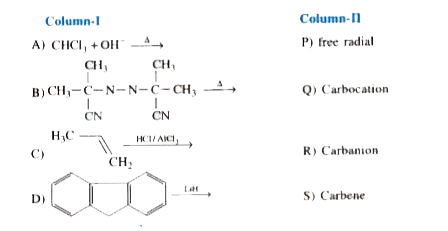Most often ordinary functional groups are attached with the following original chemical structure

(iv) CH3−CH2−CH2−CH2-
(v) CH2=CH
Which of these are coplanar systems:Solution in Telugu
(i) and (v)
(ii) and (iii)
(ii), (iii) and (iv)
(iv)
The correct Answer is:A
Step by step video, text & image solution for Most often ordinary functional groups are attached with the following original chemical structure (iv) CH_(3) - CH_(2) - CH_(2) - CH_(2)- (v) CH_(2) = CH Which of these are coplanar systems: by Chemistry experts to help you in doubts & scoring excellent marks in Class 11 exams.
Updated on:21/07/2023Topper's Solved these Questions
- GENERAL ORGANIC CHEMISTRYBOOK - AAKASH SERIESCHAPTER - GENERAL ORGANIC CHEMISTRYEXERCISE - EXERCISE - 1.1.1
8 Videos
- GENERAL ORGANIC CHEMISTRYBOOK - AAKASH SERIESCHAPTER - GENERAL ORGANIC CHEMISTRYEXERCISE - EXERCISE - 1.1.2
4 Videos
- GENERAL ORGANIC CHEMISTRYBOOK - AAKASH SERIESCHAPTER - GENERAL ORGANIC CHEMISTRYEXERCISE - Objective Exercise -2
82 Videos
- ENVIRONMENTAL CHEMISTRYBOOK - AAKASH SERIESCHAPTER - ENVIRONMENTAL CHEMISTRYEXERCISE - EXERCISE ON PASSAGE (PASSAGE-III)
5 Videos
- HYDROCARBONSBOOK - AAKASH SERIESCHAPTER - HYDROCARBONSEXERCISE - ADDITIONAL PRACTICE SHEET ( LEVEL-II (PRACTICE SHEET (ADVANCED) (MATRIX MATCHING TYPE QUESTIONS)))
5 Videos
Similar Questions
What are the main natural sources of organic compounds?
View SolutionDiscuss the principles involved in a) Sublimation and b) Crystallisation
View SolutionThe compound containing sp sp2 and sp3 hybridised carbon atoms in 1:2:3 ratio is
View SolutionOzone layer acts as one of the most important life support system. The major cause of ozone layer destruction is believed to be the release of chlorofluorocarbon compounds. UV radiation causes the chlorofluouocarbons to dissociate : CF2Clhv−−→Cl⋅+CF2CI A highly reactive chlorine atomis responsible for the decomposition of ozone. Cl⋅+O3(g)→ClO⋅+O2(g)ClO⋅+O(g)→Cl⋅+O2(g) Free radicals of chlorine decompose ozone molecules in a chain reaction. The depletion of ozone layer leading to ozone hole has, however, been mainly observed in the stratosphere over Antarctica. Special type of cloud called polar stratospheric colouds are formed over Antarctica.These clouds (contain solid HNO3.3H2O) play an important role in ozone depletion.
ClO⋅+NO2→ClONO2
ClONO2+H2O→HOCl+HNO3
ClONO2+HCl→Cl2+HNO3
HOClhv−−→HO⋅+Cl⋅
The reactive chlorine atoms thus formed are rendered to deplete ozone layer.
The ozone layer is present in :
View SolutionMatch the intermediates formed in the reaction.

View SolutionWhich of the following is an alkene? (i) CH_(3) - CH = CH_(2) (ii) CH_(2) = C = CH_(2) (iii) CH_(2) = CH - CH = CH_(2) (iv) CH_(2) = CH - (CH_(2))_(2) - CH = CH_(2)
View SolutionI. CH3−CH2−CH2−CH2−OH
II. CH3−CH2−CH∣OH−CH3
III. CH3−CH3∣C∣OH−CH3
IV. CH3−CH∣CH3−CH2−OH
V. CH3−CH2−O−CH2−CH3
VI. CH3−O−CH2−CH2−CH3
VII. CH3−O−CH∣CH3−CH3
Identify the pairs of compounds which are functional group isomers
View SolutionWhat will be the increasing order of the stability of the following alkenes?
i) H2C=CH2
ii) CH3CH=CH2
iii) CH3CH2CH=CH2
iv) (CH3)2CHCH=CH2
v) (C)CH=CH2
View SolutionThe IUPAC name of CH2=CH−CH−CH2−CH3 | CH2−CH2−CH3 is
View SolutionPredict all order of reactivity of the following compounds in dehydrohalogenation. a,. I. CH_(3)CH_(2)CH_(2)CH_(2)Cl II. (CH_(3))_(2)CHCH_(2)Cl III. (CH_(3))_(2)CH - CH_(2)Br IV. CH_(3)CH(Br)CH_(2)CH_(3) V. (CH_(3))_(3) C - Br b. I. CH_(3)CH(Br)CH_(3) II. CH_(3)CH_(2)CH_(2)Br III. (CH_(3))_(2) CH - CH_(2) Br IV. (CH_(3))_(3)C - CH_(2) Br
View Solutionनिम्नलिखित यौगिकों के आई.यु.पी.ए.सी.नाम लिखिए |
(i) (CH3)2CH−CH=CH−CH3−CH || CH3−CH−CH ∣ C2H5
(ii)
CH2=C(CH2CH2CH3)2
(iv) CH3CH2CH2 CH2CH2CH3 | | CH3−CHCH=C−CH2−CHCH3 ∣ CH3
View SolutionThe IUPAC name of {:(CH_(2) = CH-CH-CH_(2)-CH_(3)),(" |"),(" "CH_(2)-CH_(2)-CH_(3)):} is
View Solutionनिम्नलिखित यौगिक का सही नाम है -
CH3 |CH3CH2−C=CH−CH−CH2−CH3 |CH3CH2−CH−CH2−CH2−CH3
View SolutionName the following compounds according to IUPAC system. (i) CH_(3) - CH_(2) - underset (CH_(2)Cl) underset(|)(CH) - overset (CH_(2)OH) overset(|) (CH) - underset (CH_(3)) underset (|) (CH) - CH_(3) CH_(3)- underset (CH_(3)) underset(|) (CH) -CH_(2) - underset(OH) underset(|) (CH) - overset (CH_(2)OH) overset(|) (CH) - CH_(2) (iii) (iv) H_(2)C = CH - underset (OH)underset (|) (CH) - CH_(2) - CH_(2) - CH_(3) (v) CH_(3) - underset (CH_(3)) underset ( |) C = underset (Br)underset(|) C - CH_(2)OH
View Solutionwrite the IUPAC name {:(CH_(3)CH_(2)CH_(2)CH_(2)" "CH_(2)CH_(3)" "CH_(3)),(" | | |"),(" "CH_(3)-CH-C=CH-CH_(2)-CH-CH_(3)):}
View Solution
